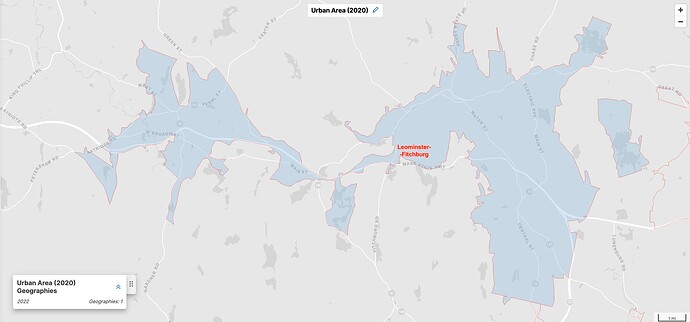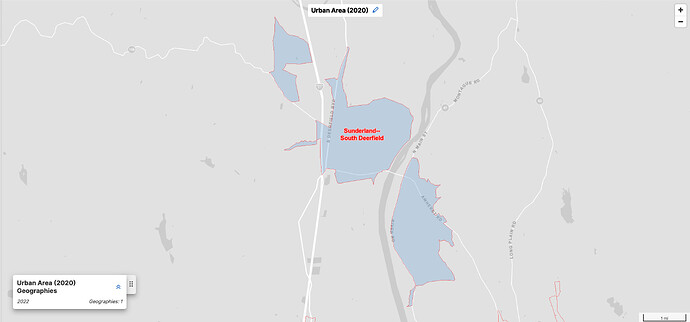This would validate the threshold of around 100,000 to 110,000 that I floated above. If we want to apply the same framework nationwide, we’d need more gut checks along these lines.
In order to choose which titled places within the Leominster–Fitchburg UA would qualify for place=city, we would essentially have to split the UA in two. It certainly wouldn’t make sense to double-count the entire UA’s population by classifying both places as city. Roughly halving the UA’s population would likely cause it to fall well below the threshold for any city within the UA, matching your expectations.
Likewise, if we roughly halve the Sunderland–South Deerfield UA’s population, it would easily fall below the threshold for a place=village within the UA.
Other double- and triple-barreled UAs may be less obvious just judging by title or appearance. Of course, it would be great if we could more precisely divvy up the UA’s population rather than “roughly halving” it. The process for defining a UA involves creating urban area agglomerations that probably correspond to lobes like the ones above, but I don’t think they publish those intermediate geographies.
Did you find my “would have suburbs around it” test useful in identifying Fall River as a place=city within that UA? If not, we could look for a more rigorous standard. Through the 2000 census, the Census Bureau designated central places within Urban Clusters and Urbanized Areas. They dropped these lists in 2010, considering them redundant to the principal cities in CBSAs. Should we reintroduce the previous central place concept or adopt CBSA principal cities to supplement the places in the UA’s title? Previously, I found that principal cities tended to overpopulate some of the larger MSAs with too many place=city contenders, 19 in the Los Angeles–Long Beach–Anaheim MSA alone.
Barnstable Town is an MCD. By the rules for naming UAs, this means the Census Bureau couldn’t find within the UA a specific populated place with at least 2,500 people, or even a CDP. On that basis, we can say that no place within Barnstable Town should be a place=city, even if we set the floor for a city-based UA at 100,000 or so.
Do you feel strongly about also including Portsmouth and Bangor as place=city? The Dover–Rochester UA’s population would be split between the two cities, so there’s no problem denying both that coveted city status. But Bangor would really blow a hole in any threshold around 100,000. Bangor would also frustrate other heuristics that have been proposed in the past, like the presence of an international airport, so maybe there’s just something special about it that shouldn’t sway a regional or national classification standard.

